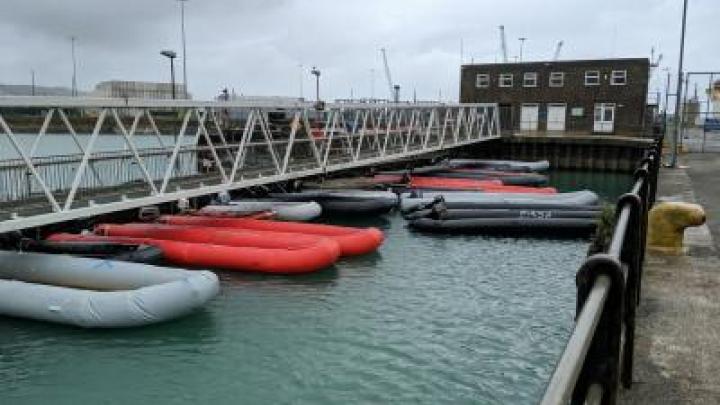Book Review: The European Commission and the Transformation of EU Borders
Posted
Time to read
Guest post by Susi Foerschler, 2017 graduate of Vanderbilt University Law School’s LL.M. program and German lawyer with an academic focus on public international law.
Review of The European Commission and the Transformation of EU Borders, by Valentina Kostadinova (Palgrave, 2017).

Jean Monnet believed that “beyond differences and geographical boundaries there lies a common interest”. European integration is the endeavor of shaping that common interest into what Kostadinova describes as a “post-national borderless space” (1). A primary actor in that effort is the European Commission, a supranational organization with unique powers to introduce legislation and further policies that shapes the EU on a day-to-day basis. Analyzing a specific set of Commission documents, the study evaluates four key policy areas of relevance to the EU migration regime namely, border controls, the free movement of people, social policy, and the European Neighborhood Policy (ENP). The text analyzes how the Commission affects change towards integration in these policy areas. Most importantly, it also looks critically at the Commission’s conduct that frequently contradicts the notion of a novel organization whose only goal is de-bordering. Kostadinova drives home the point that Europe is not heading towards the utopia of a post-national borderless space by referring to Commission measures that create a divide between the “EU Self” and the “Other”, i.e. non-EU nations and citizens, which is symptomatic in the creation of identity borders. However, the Commission is transforming borders and common spaces, which leads Kostadinova to regard the Union as a “laboratory where many new trends first emerge” and that allows a glimpse into the future of border development in general (3). To that end, the empirical chapters of the book (chapters 2-5) take stock of the existence and boundaries of EU common spaces.
In the first empirical chapter, Kostadinova scrutinizes the transformation of territorial borders by examining border controls. The findings reveal a sharp contrast between internal and external EU borders. While internally the process of de-bordering is mostly successful, a traditional understanding of salient EU external borders prevails with the European Commission. External border control still relies on the national border control capacities of member states and do not reflect the idea of a post-national entity. Interestingly, this is the only policy area where Commission documents explicitly refer to the EU’s external borders whereas in other policy areas, these borders are not directly acknowledged. Kostadinova further touches upon the (re)creation of internal territorial and identity borders. Notably, new antagonists emerge such as EU citizens versus third-country nationals (TCNs), wanted versus unwanted migrants, and rich versus poor that have diverse rights and opportunities to enter and move within the EU. While borders are de-constructed for one group, they become more impenetrable for the other.
In chapter 3, Kostadinova turns to the free movement of people (FMP) and functional border transformation. Controlling the movement of people across borders is one of the last strongholds of the Westphalian state, and the FMP [is] a feature unique to the EU. Scrutinizing the de-bordering effects of FMP in this study provides useful insights towards the creation of a borderless world. A major part of this chapter focuses on the divisions between EU citizens and TCNs. Although the Commission promotes a common space for both groups, its competence is limited to creating a common space for EU citizens. Free movement of TCNs is still regulated by member states which limits TCNs’ participation in FMP. However, even more thought-provoking is Kostadinova’s further finding that the free movement of less well-off EU citizens is equally limited by functional obstacles such as a fragmented social security system.
In chapter 4, Kostadinova moves on to examine the effects of social policy and the construction of a European identity on borders. She reminds the reader of the important role social policy played in the establishment of the Westphalian state and emphasizes the potential of this policy in border transformation. While a common social policy creates solidarity, and contributes to the emergence of a European identity, with a stronger “EU Self” comes a sharper divide with the “Other”. Kostadinova, however, admits to the practical limits of this policy as the Commission currently does not have the competence to further a European social policy.
Chapter 5 covers a bouquet of topics on EU external relations, or in the Commission’s words, the policy devised to create a “ring of friends” (p. 153). Studying the Commission’s reactions to the Arab Spring and the Ukraine crisis, Kostadinova deduces that in external relations, the EU is far from the post-modern utopia. It gets actively involved in geopolitical struggles, even behaves as a regional hegemon, and, as a result, shapes international relations on the whole continent. Surprisingly, the Commission depicts the “ring of friends” as a source of danger for the EU. Kostadinova claims that there is an inherent contradiction between striving to establish a common space between the EU and its partners while adhering “to the proclaimed EU practice of observing human rights or individual freedoms” (p. 74) and the promotion of exclusionary practices by the Commission. Kostadinova determines that in all four policy areas the Commission privileges security over the aforementioned core values of the “EU Self” and concludes that these circumstances reinforce territorial borders and the divide between the “EU Self” and the “Other” alike.
The study’s conclusion draws upon the Fortress Europe metaphor where EU external borders become more salient, diametrically opposed to the advancement of internal de-bordering. The EU could have a true post-national future. At present, though, borders are sacrosanct, although the Commission, itself an institution closer to post-nationalism than Westphalia, creates and maintains common spaces in many policy areas. Kostadinova’s intention is not to offer solutions to her findings. Her study superbly develops the Commission’s struggles, successes and weaknesses in contributing to border transformation in the EU. Moreover, it offers a comprehensive overview of the academic debate on the topic. Kostadinova’s study needs to be on the must-read list of scholars with a migration and European Union focus alike. It is an excellent consolidation of and starting point for further research on the role of international actors other than states in the transformation of borders. At the same time, it offers valuable insights into the operation and development of the European Union from a multidisciplinary angle. Last, but by no means least, the Commission itself would be well advised to carefully consider Kostadinova’s findings in going forward.
Any comments about this post? Get in touch with us! Send us an email, or post a comment here or on Facebook. You can also tweet us.
__________
How to cite this blog post (Harvard style)
Foerschler, S. (2017) Book Review: The European Commission and the Transformation of EU Borders. Available at: https://www.law.ox.ac.uk/research-subject-groups/centre-criminology/centreborder-criminologies/blog/2017/10/book-review (Accessed [date])
Share
YOU MAY ALSO BE INTERESTED IN
With the support of









